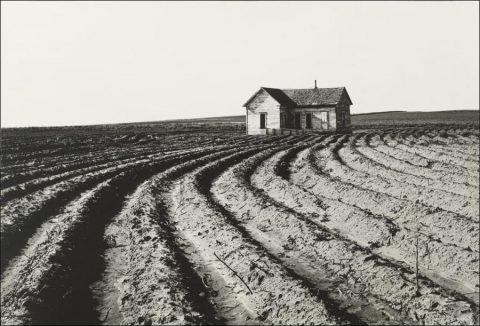In the months leading up to the election, museums and galleries across America will host a number of impassioned and political exhibitions.
There has been a surge in impassioned political art since the 2016 election, from public art at the border wall with Mexico, to billboard art across all 50 states and public podiums where consumers have been invited to voice their opinions (rather than use art as a backdrop for Instagram selfies).
With all eyes on this year’s presidential election, it tracks that museums and galleries across America will be flooded with even more of it in the months prior. A great deal of the artwork going on view over the next 12 months will aim at raising awareness about the importance of voting. It might also sway voters towards a more sensible direction. While some exhibitions have yet to be announced, here are six that will surely make an impact, from paintings of white supremacists to resistance art, war murals and activism.
Jacob Lawrence: The American Struggle
The 20th-century African American artist Jacob Lawrence painted political turmoil, from the first world war to the American Revolution. He was known for depicting the lives of black Americans and his Migration Series was the first artwork by a black artist to be acquired by the Museum of Modern Art. Now, Lawrence’s work is going on view at the Peabody Essex Museum in Salem on 18 January (it travels next to the Metropolitan Museum of Art in New York). His paintings will be shown alongside young artists working today, from Derrick Adams to Hank Willis Thomas. The artist, who died in 2000, wanted to depict “the struggles of a people to create a nation and their attempt to build a democracy”.

Dorothea Lange Words & Pictures
From 9 February at the Museum of Modern Art, works by Dorothea Lange, the iconic American photographer, will go on view. From early street photography to a concerted effort to follow criminal justice reform, Lange is known for showing the human condition through her photographic lens – and American suffering. A large part of the show is based upon her 1939 photo book, An American Exodus, which details the impact of the Dust Bowl migration during the Depression, when midwesterners migrated to California for jobs. Her most famous photograph is Migrant Mother, a photo of a woman in Nipomo, California, taken in 1936. As Lange once said: “All photographs – not only those that are so called ‘documentary’… can be fortified by words.”
African American Artists and the European Modernist Tradition
Opening 29 February at the Phillips Collection in Washington, 72 artworks by 54 artists highlight how many African American artists responded to European modernism. Some of the country’s greatest artists, including Faith Ringgold and Carrie Mae Weems, will be shown alongside modernist artists whose work they have cited – and criticized – from Pablo Picasso to Henri Matisse.
It’s what the exhibition’s curator, Adrienne L Childs, calls cross-cultural conversations. “This exhibition shows the ways in which many African American artists draw on the substance of European art history to tell their own stories,” said Childs. “We hope to enhance the narrative of modern and contemporary art in America by presenting the compelling works born of these riffs and relations.”
Philip Guston Now
The Montreal-born painter Philip Guston has had a resurgence over the past few years (a recent retrospective in Venice, a display of his political cartoons at Hauser & Wirth). Now, he’s making a full comeback on 7 June with an exhibition featuring over 200 paintings and drawings at the National Gallery of Art in Washington (it travels next to the Museum of Fine Arts in Houston this fall, then the Tate Modern in 2021).
While Guston is remembered as one of the greatest modern painters, his political art shocked the art world in the 1960s – he painted Ku Klux Klansmen with blood-covered outfits and created satirical drawings of Richard Nixon. As the artist once said: “When the 1960s came along, I was feeling split, schizophrenic. The war, what was happening in America, the brutality of the world. What kind of a man am I sitting at home, reading magazines, going into a frustrated fury about everything – and then going into my studio to adjust a red to a blue? I thought there must be some way I could do something about it.”
Vaginal Davis: The White to Be Angry
The transgender activist and performance artist Vaginal Davis was a key figure in the queer music scene in Los Angeles in the 1970s. Opening 1 February at the Art Institute of Chicago, she is showing a retrospective of films, music, zines and art that shows her integral contribution to queer art. As a co-founder of the homocore music movement that influenced riot grrrl culture in the 1990s, her film The White to Be Angry from 1999 zeroes in on white supremacy in American politics. The exhibition is meant to “embrace ambiguity and extravagant dark humor, creating an image of America that remains unnervingly topical today”.
Her Story: A Century of Women Writers
Opening 10 July and running through 2021, the National Portrait Gallery in Washington is honoring 24 notable female writers from the past century in a new exhibition of portraits. From Joyce Carol Oates, a Twitter critic of Donald Trump, to Gwendolyn Brooks, the first African American writer to win a Pulitzer prize for literature in 1950.
There are also portraits of Jhumpa Lahiri, Anne Tyler, Alice Walker and Toni Morrison (who received the Nobel prize for literature in 1988). As part of the Smithsonian American Women’s History Initiative Because of Her Story, it’s curated by the gallery’s historian, James Barber. As Oates recently said of the Trump presidency: “While this era now is also upsetting, I think that we’ll look back on it as just an era.”
Hits: 61
